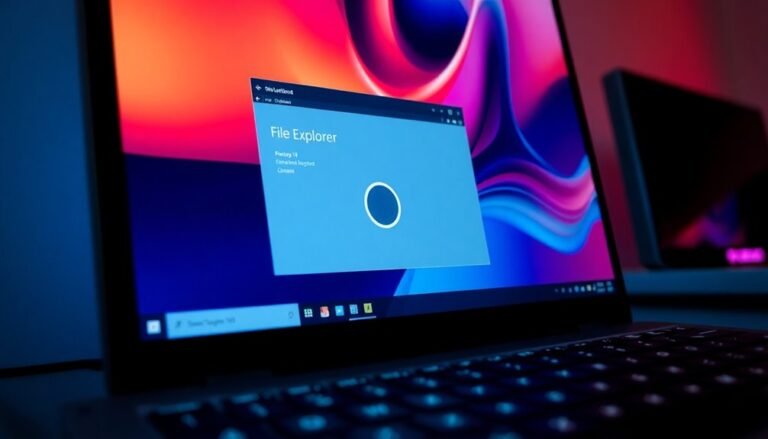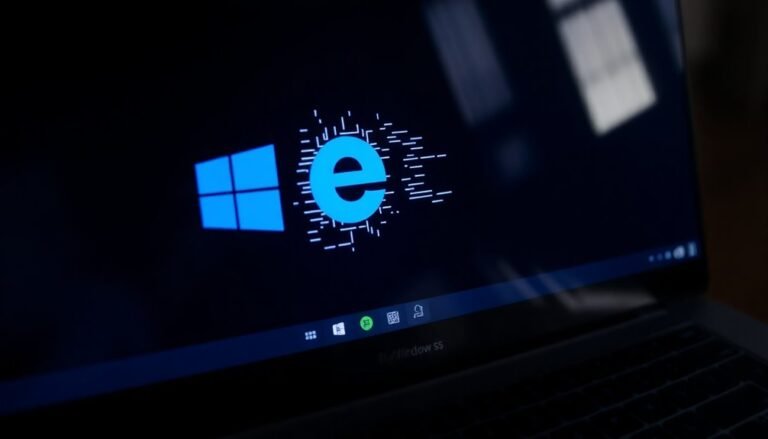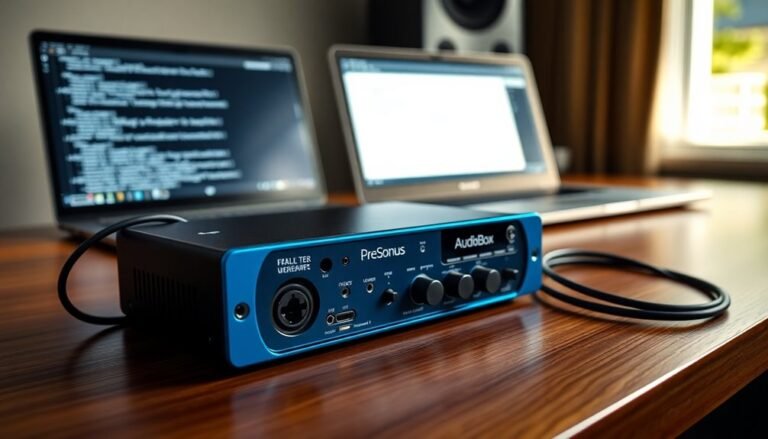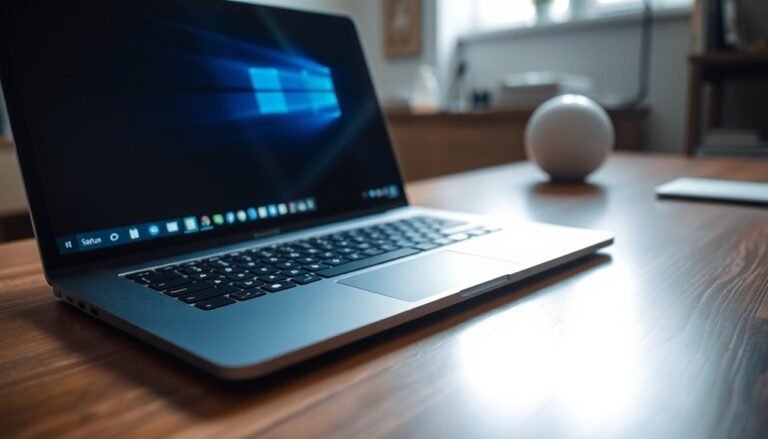Windows Key Not Working Windows 11: Fix Start Menu Shortcut

If your Windows key isn’t working in Windows 11 and you can’t open the Start menu, first check if your keyboard has a “Win Lock” or gaming mode that’s accidentally activated.
Try plugging your keyboard into another port, cleaning it, and restarting Windows Explorer in Task Manager.
Also, update or reinstall keyboard drivers using Device Manager. Run `sfc /scannow` in Command Prompt to fix possible system file issues.
There’s more you can try to fully restore keyboard shortcuts and smooth workflow ahead.
Common Reasons Why the Windows Key Stops Working

Why Your Windows Key Is Not Working in Windows 11: Common Causes and Fixes
If your Windows key stops working in Windows 11, it can be due to various hardware or software issues. Start by checking your keyboard connection—loose USB cables or wireless receivers can cause the Windows key to malfunction.
Physical damage or a stuck Windows key might also be responsible. To rule out hardware failure, try using your keyboard on a different device. Some keyboards include a “Windows Lock” key that disables the Windows key when activated, so make sure this feature isn’t enabled.
Additionally, outdated or corrupted keyboard drivers can prevent the Windows key from functioning properly. If you notice that the Start button is freezing or acting unresponsive, this may also indicate deeper system conflicts that affect the Windows key’s operation.
On the software side, Windows 11 accessibility features like Filter Keys, Sticky Keys, or Game Mode may interfere with the Windows key response. Changes in the Windows registry or group policy settings might disable the Windows key or its shortcuts.
System updates, bugs, or corrupted system files can also disrupt keyboard input. Furthermore, background applications, malware infections, or manufacturer-specific utilities might override or disable the Windows key.
To fix these issues, perform targeted troubleshooting such as updating drivers, scanning for malware, checking system files, and reviewing system settings to restore your Windows key functionality in Windows 11.
Recognizing the Symptoms and Impact on Productivity
Windows 11 Keyboard Shortcut Not Working? Here’s How to Recognize the Symptoms and Boost Productivity
If your Windows key stops responding in Windows 11, you’ll notice that pressing it no longer opens the Start menu. Essential keyboard shortcuts like Win + D (show desktop) or Win + Tab (Task View) also fail to work.
Sometimes, the Windows key may be completely unresponsive, while certain shortcuts such as Win + L (lock screen) still function, creating inconsistent behavior. This problem often arises suddenly without any physical damage and continues even after restarting your PC. Recent system updates can alter keyboard behavior and disable key functionalities, so it’s important to consider if changes were made to your system prior to the issue.
Without visual or system feedback, this issue can severely impact your workflow.
How does a non-working Windows key affect your productivity?
- Workflow Disruption in Windows 11: Losing quick access to Snap layouts, Widgets, and the Start menu slows down multitasking and overall navigation.
- Increased User Frustration: Searching for alternative ways to perform tasks raises stress levels and reduces focus.
- Efficiency Loss for Power Users: IT professionals, gamers, and accessibility users experience noticeable slowdowns without reliable keyboard shortcuts.
- Potential Broader System Instability: Keyboard input issues may signal underlying system problems, further degrading your Windows 11 experience.
If you’re experiencing the Windows key not working in Windows 11, understanding these symptoms is crucial to restoring your productivity.
Stay tuned for troubleshooting tips to quickly fix Windows 11 keyboard shortcut issues and get your workflow back on track.
Checking Keyboard Settings and Gaming Modes
How to Fix a Non-Responsive Windows Key in Windows 11: Check Keyboard Settings and Gaming Mode
If your Windows key isn’t working in Windows 11, start by checking your keyboard settings and gaming modes—common reasons behind this issue.
First, ensure your keyboard layout matches your physical keyboard. To do this, go to Settings > Time & Language > Language & Region > Keyboard and confirm the correct layout is active. Remove any unnecessary or conflicting languages, and use the Windows Key + Space shortcut to quickly switch and verify your current input method.
Next, verify if your keyboard’s Gaming Mode is enabled. Gaming Mode often disables the Windows key to prevent accidental interruptions during gameplay. Look for a physical toggle switch, function (Fn) key combinations, or LED indicators on your keyboard.
Many gaming keyboards also include software utilities that allow you to enable or disable Gaming Mode or the Windows key—check your keyboard manufacturer’s software for these settings.
Additionally, check accessibility settings in Windows 11 by navigating to Settings > Accessibility > Keyboard. Make sure that features like Filter Keys, Sticky Keys, or Toggle Keys aren’t interfering with your keyboard input.
Adjust or disable these settings if necessary to restore normal Windows key functionality.
By following these steps to review keyboard layout, disable Gaming Mode, and adjust accessibility settings, you can quickly troubleshoot and fix a non-responsive Windows key on Windows 11.
For more detailed solutions, explore additional Windows troubleshooting guides.
Software Troubleshooting Steps for Windows Key Issues

How to Fix Windows Key Not Working Issues on Windows 11: Step-by-Step Troubleshooting Guide
If your Windows key is not working on Windows 11, the cause is often related to software conflicts or system misconfigurations rather than hardware problems. To help you quickly resolve this common issue, follow our comprehensive troubleshooting steps designed to reset system settings, repair corrupted files, and check accessibility options that may interfere with your keyboard functionality.
1. Edit the Windows Registry to Fix Windows Key Issues
Access the Registry Editor by typing `regedit` in the search bar. Navigate to `HKEY_LOCAL_MACHINESYSTEMCurrentControlSetControlKeyboard Layout`. Look for the `Scancode Map` entry and delete it if it exists, as this can disable the Windows key. Additionally, review the `i8042prt` settings to ensure keyboard ports are correctly configured. Always remember to back up your registry before making any changes to avoid system risks.
2. Use PowerShell Commands to Repair Windows Key Functions
Run PowerShell as an administrator and execute the app re-registration command:
`Get-AppXPackage -AllUsers | Foreach {Add-AppxPackage -DisableDevelopmentMode -Register “$($_.InstallLocation)AppXManifest.xml”}`
This command helps restore essential system components that affect the Windows key behavior.
3. Repair System Files Using DISM and SFC Tools****
Open Command Prompt as administrator and run the following commands to detect and fix corrupted system files:
- `DISM /Online /Cleanup-Image /RestoreHealth`
- `sfc /scannow`
These tools repair Windows system files that might cause keyboard malfunctions.
4. Check and Disable Accessibility Features That May Block the Windows Key
Go to Settings > Accessibility and turn off features such as ‘Filter Keys’ and ‘Sticky Keys’. These accessibility options sometimes interfere with keyboard inputs, including the Windows key.
Investigating Hardware and External Device Factors
Troubleshooting Windows Key Not Working in Windows 11: Hardware and External Device Solutions
If your Windows key stops working in Windows 11, hardware and external device issues could be the cause. Begin by testing your keyboard on a different computer. If the Windows key fails on multiple devices, it might indicate physical damage, worn-out key switches, or internal defects that require repair or replacement.
For users with external keyboards, try connecting via different USB or Bluetooth ports to rule out damaged connectors or intermittent connections that affect key functionality.
Ensure your keyboard and motherboard chipset drivers are up to date by using Device Manager. Outdated or generic drivers can prevent special keys like the Windows key from functioning correctly. Some keyboards also need manufacturer-specific software or firmware updates for full compatibility with Windows 11, so check the manufacturer’s website for the latest updates.
If you’ve recently upgraded your hardware, such as installing a new motherboard, verify that Windows 11 is properly activated, as activation issues can sometimes impact system features, including key functionality.
Additionally, review your USB power management settings in Device Manager to ensure USB ports aren’t being disabled to save power—this is especially important if you use USB hubs or adapters.
Temporary Workarounds to Regain Start Menu Access
How to Fix the Windows Key Not Working in Windows 11: Temporary Workarounds to Access the Start Menu
If the Windows key stops working in Windows 11, don’t worry—there are quick and easy temporary workarounds to regain access to the Start Menu without diving into complex troubleshooting.
These effective methods help you restore Start Menu functionality and navigate your system smoothly while you identify the root cause. Follow these proven steps to fix Windows key issues and maintain productivity:
1. Restart Windows Explorer to Fix Windows Key Problems
Press Ctrl + Shift + Esc to open Task Manager. Find “Windows Explorer” under the Processes tab, right-click it, and select “Restart.”
If you don’t see Windows Explorer, click on File > Run new task, type explorer, and hit Enter. Restarting Windows Explorer often resolves Start Menu and Windows key glitches.
2. Reboot Your PC to Resolve Windows Key Malfunctions
Sometimes, a simple restart is the quickest fix. Reboot your computer to clear temporary software conflicts or stuck background processes that may disable the Start Menu or Windows key.
3. Use Alternative Keyboard Shortcuts to Access the Start Menu
If your Windows key isn’t working, try pressing Ctrl + Esc to open the Start Menu.
You can also use Win + X (or right-click the Start button) to open the Quick Link menu, and Win + I to launch Settings directly. These shortcuts provide instant access to key Windows features.
4. Uninstall Recent Windows Updates Causing Windows Key Issues
If the problem began after a recent update, uninstalling it may help. Go to Settings > Update & Security > Windows Update > View update history****, then remove the problematic update to restore normal Windows key functionality.
By applying these temporary fixes to your Windows 11 PC, you can quickly regain Start Menu access and keep working efficiently while troubleshooting the Windows key issue.
For more detailed solutions, consider checking for driver updates or running the Windows troubleshooter.
Preventive Measures and Permanent Solutions

How to Fix Windows Key Not Working in Windows 11: Preventive Measures and Permanent Solutions
To ensure your Windows key works flawlessly in Windows 11, it’s essential to tackle both software and hardware issues. First, keep your keyboard drivers up to date by downloading the latest versions directly from your manufacturer’s website or using Windows Update—avoid third-party driver tools to prevent compatibility problems.
If the Windows key still doesn’t respond, uninstall the keyboard driver via Device Manager and restart your PC to trigger a fresh driver installation.
For gamers, make sure gaming mode or “Win Lock” features are turned off, as these can disable the Windows key. Also, check Windows 11 accessibility settings like Filter Keys, Sticky Keys, or Toggle Keys that may interfere with keyboard inputs.
Run the System File Checker tool by opening an elevated Command Prompt and typing `sfc /scannow` to scan and repair corrupted system files. Follow up with DISM commands (`DISM /Online /Cleanup-Image /RestoreHealth`) to fix deeper system issues affecting keyboard performance.
Additionally, perform regular malware scans using Windows Defender or trusted antivirus software to eliminate any malicious software disrupting keyboard functions.
Lastly, test your keyboard on another PC to determine if hardware failure is the root cause. Clean your keyboard thoroughly, repair any physical damage, or replace it if necessary to permanently fix Windows key problems in Windows 11.
Frequently Asked Questions
Does the Windows Key Not Working Affect Remote Desktop Sessions?
Yes, if your Windows key doesn’t work locally, it can impact Remote Desktop sessions, especially if RDP is set to pass Windows key shortcuts. You’ll need to use alternative shortcuts like Alt+Home to access remote Start Menu functions.
Can the Issue Be Related to Specific Windows 11 Updates?
Several specific Windows 11 updates sometimes spark shortcut snags, causing your Windows key to stop working. You’ll want to watch for recent patches, system file changes, or driver conflicts, and consider rolling back or reinstalling updates as troubleshooting steps.
Will Reinstalling Only the Keyboard Driver Erase My Custom Shortcuts?
No, reinstalling only the keyboard driver won’t erase your custom shortcuts. Your shortcuts are usually stored in system settings or third-party tools, not the driver. However, always back up configurations and verify after reinstalling to guarantee nothing’s lost.
Are There Registry Tweaks to Customize or Re-Enable the Windows Key?
Yes, you can customize or re-enable the Windows key using registry tweaks. Edit or delete the “Scancode Map” value under HKEY_LOCAL_MACHINESYSTEMCurrentControlSetControlKeyboard Layout, then restart. Always back up your registry before making changes.
Can Accessibility Settings Interfere With the Windows Key Functionality?
Over 60% of reported Windows key issues involve accessibility settings. You’ll find that enabling Sticky or Filter Keys can block or alter your Windows key’s response. Disable these features in Settings > Accessibility > Keyboard to resolve conflicts.
Conclusion
Don’t let a stubborn Windows key throw a wrench in your workflow. By following these troubleshooting steps—checking settings, software, and hardware—you’ll quickly zero in on the culprit and restore full Start menu access. Remember, a little preventive maintenance goes a long way in keeping your shortcuts smooth and your productivity high. Stay proactive, and you’ll keep that Windows key working like a charm, no matter what bumps you hit along the way.





